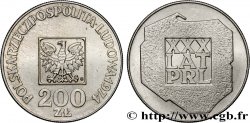- Accueil
- > Archiv
- > Weltmünzen
fwo_648220 - POLEN 10 Mark Ghetto de Lodz 1943
Nicht verfügbar.
Artikel auf unserem Online-Shop verkauft (2022)
Preis : 200.00 €
Artikel auf unserem Online-Shop verkauft (2022)
Preis : 200.00 €
Type : 10 Mark Ghetto de Lodz
Datum: 1943
Prägemenge : -
Metall : Aluminium
Durchmesser : 28,3 mm
Stempelstellung : 12 h.
Gewicht : 2,63 g.
Rand lisse
Kommentare zum Erhaltungszustand:
coups à l’avers
N° im Nachschlagewerk :
Vorderseite
Titulatur der Vorderseite GETTO / 1943.
Beschreibung Vorderseite Étoiles à six branches, double cercles avec étoiles.
Rückseite
Titulatur der Rückseite DER AELTESTE DER JUDEN IN LITZMANNSTADT.
Beschreibung Rückseite QUITTUNG ÜBER // 10 / MARK.
Kommentare
Suite à l’invasion de la Pologne en 1939, la ville polonaise de Lodz est rattachée au Reichgau Wartherland et rebaptisée Litzmannstadt du nom du général Karl Litzmann. A partir de 1940, est créé un ghetto qui est à la fois un camp de concentration et un centre industriel important. En 1944, suite à l’avancée des troupes soviétiques les survivants du ghetto son évacués vers les camps d’extermination et .
Le Mark du ghetto est introduit en 1940 sous forme de billets puis en 1942 et 1943 sous forme de monnaie de 10 Pfennig, 5, 10 et 20 Mark et devient la seule monnaie autorisée du ghetto.
Following the invasion of Poland in 1939, the Polish city of Lodz was annexed to the Reichgau Wartherland and renamed Litzmannstadt after General Karl Litzmann. From 1940 onwards, a ghetto was created which was both a concentration camp and an important industrial centre. In 1944, following the advance of the Soviet troops, the survivors of the ghetto were evacuated to the extermination camps and . The Ghetto Mark was introduced in 1940 in the form of banknotes and then in 1942 and 1943 in the form of 10 Pfennig, 5, 10 and 20 Mark coins and became the only authorised coin in the ghetto.
Le Mark du ghetto est introduit en 1940 sous forme de billets puis en 1942 et 1943 sous forme de monnaie de 10 Pfennig, 5, 10 et 20 Mark et devient la seule monnaie autorisée du ghetto.
Following the invasion of Poland in 1939, the Polish city of Lodz was annexed to the Reichgau Wartherland and renamed Litzmannstadt after General Karl Litzmann. From 1940 onwards, a ghetto was created which was both a concentration camp and an important industrial centre. In 1944, following the advance of the Soviet troops, the survivors of the ghetto were evacuated to the extermination camps and . The Ghetto Mark was introduced in 1940 in the form of banknotes and then in 1942 and 1943 in the form of 10 Pfennig, 5, 10 and 20 Mark coins and became the only authorised coin in the ghetto.








 Berichten über einen Fehler
Berichten über einen Fehler Die Seite drucken
Die Seite drucken Teilen meiner Auswahl
Teilen meiner Auswahl Stellen Sie eine Frage
Stellen Sie eine Frage Einlieferung/Verkauf
Einlieferung/Verkauf
 Details
Details















